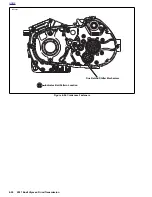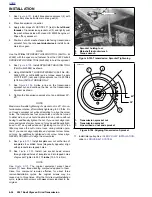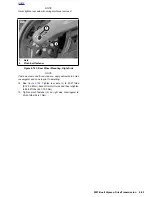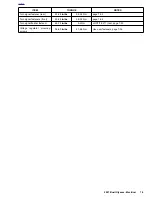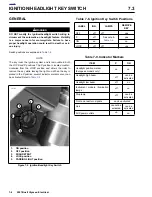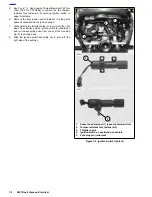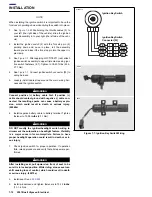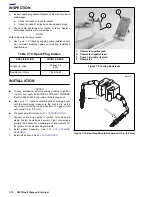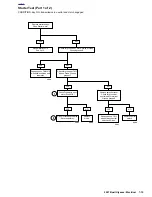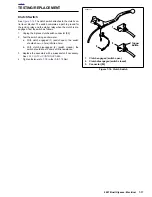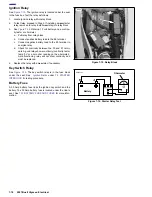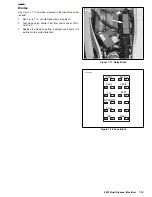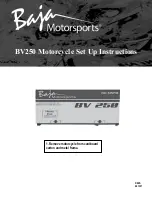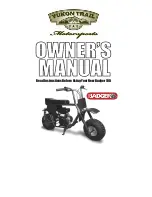
7-4
2007 Buell Ulysses: Electrical
HOME
IGNITION SYSTEM
7.2
GENERAL
The vehicle uses a breakerless inductive-discharge ignition
system. The system has both a primary and secondary cir-
cuit. The primary circuit consists of the battery, main fuse,
ignition switch, primary coil windings, computerized ignition
timer and associated wiring. The secondary circuit consists of
the secondary coil, spark plugs and associated wiring. See
Figure 7-1.
DIGITAL TECHNICIAN (Part No. HD-44750) can access the
information received by and stored in the electronic control
module.
The electronic control module (ECM) is located under the
seat. The module has three primary functions. First, it com-
putes the spark advance for proper ignition timing based on
sensor input. Second, it controls the independent, primary
windings of the spark coil and is thus able to provide sequen-
tial and independent firing of the spark plugs (non waste
spark). Third, it calculates the correct air/fuel ratio based on
input from the sensors.
The electronic control module contains all the solid-state
components used in the ignition system. The dwell time for
the ignition coil is also calculated by the ECM microprocessor
and is dependent upon battery voltage. The programmed
dwell is an added feature to keep battery drain to a minimum
and to adequately charge the coil at all speeds. The ECM has
added protection against transient voltages, continuous
reverse voltage protection and damage due to jump starts.
The ECM is fully enclosed to protect it from vibration, dust,
water and oil. The module is not repairable. Replace the unit if
it fails.
The ECM uses six different sensors to monitor rider demands
and changing engine conditions. These sensors are:
●
Throttle Position (TP) Sensor
●
Cam Position (CMP) Sensor
●
Intake Air Temperature (IAT) Sensor
●
Engine Temperature (ET) Sensor
●
Oxygen (O2) Sensor
●
Bank Angle Sensor (BAS)
●
Interactive Muffler Valve Position Sensor
(Built-in to the actuator)
The ECM uses the information provided by the throttle posi-
tion and cam position sensors to calculate how much air is
entering the engine.The throttle position sensor monitors the
amount of air entering the engine by how far the throttle is
open, whether it is opening or closing and how fast it is open-
ing or closing. The IAT sensor measures the temperature of
the air entering the engine, providing the rest of the informa-
tion necessary to determine the density of the air entering the
engine. The ECM also monitors the cam position sensor to
determine the exact position of both cylinders in the combus-
tion cycle and the engine speed.
The ET sensor provides the ECM the current engine temper-
ature. Proper fuel and spark delivery are dependent on the
temperature of the engine. The ECM will provide a richer fuel
mixture on start up and a higher degree of spark advance. As
the vehicle warms up to operating temperature the fuel mix-
ture will lean and the spark advance will decrease.
On the 1200 models, an interactive exhaust system utilizes
an actuator valve in the muffler which is connected to a servo
motor via a cable. The valve position automatically adjusts to
enhance engine performance.
Cooling fan actuation is controlled by the ECM. With key ON,
fan turns on when engine cylinder head temperature reaches
220° C (428° F) and shuts off when temperature reaches
180° C (356° F). With key OFF, fan turns on when engine
temperature reaches 170° C (338° F) and shuts off when
temperature reaches 150° C (302° F).
The information provided by the O2 sensor allows the ECM to
ensure a proper air/fuel mixture by monitoring the final com-
bustion efficiency in the exhaust system. This ensures opti-
mum engine performance at any altitude or barometric
pressure. The O2 sensor input to the ECM is required to
ensure a stoichiometric (14.7:1) air/fuel ratio during closed
loop operation.
The Bank Angle Sensor (BAS) provides input to the ECM on
whether the vehicle lean is greater than predetermined bank
angle limit. As long as lean angle does not exceed limit, fuel
supply and ignition operation are unaffected. If the vehicle
exceeds the predetermined bank angle limit, the BAS will
interrupt the operation of the ignition system and fuel supply.
To reset system, return vehicle to the upright position and
switch key OFF.
The ECM-controlled ignition coil fires each spark plug inde-
pendently on the compression stroke of each cylinder (no
waste spark). The spark plug in the front cylinder fires at the
end of that cylinder’s compression stroke, thereby igniting the
air/fuel mixture. The same sequence occurs at the end of the
rear cylinder’s compression stroke (thereby igniting the air/
fuel mixture in the rear cylinder).
The rotor and cam position sensor are located in the gear-
case cover on the right side of the motorcycle. The Cam posi-
tion sensor consists of a Hall-effect device, magnet and plate.
The plate is mounted over a rotating cup (“rotor cup”). The
rotor cup is mounted on the camshaft and operates at one-
half crankshaft speed. As the rotor cup turns inside the gear-
case, six asymmetrical teeth on the rotor cup sequentially
break the magnetic field between the magnet and the Hall-
effect device. The edges of these teeth are cut to correspond
to specific positions of the camshaft during the engine cycle
such as TDC for the front cylinder. The output of the cam
position sensor is used by the ECM to not only determine
engine position, but also to calculate engine speed. This
method of measuring camshaft position provides accurate
information on engine position down to zero engine speed.
For more information on the sensors used in conjunction with
the ECM see Section 4 Fuel System.
See the wiring diagrams in the Appendix for additional infor-
mation on ignition system circuits.
TROUBLESHOOTING
See Section 4 Fuel System for troubleshooting information.
Summary of Contents for 2007 ULYSSES
Page 17: ...A 16 2007 Buell Ulysses Appendix A HOME NOTES ...
Page 51: ...D 2 2007 Buell Ulysses Appendix D HOME Figure D 2 Rear Brake Systems Top View b1115acsxu ...
Page 63: ...D 14 2007 Buell Ulysses Appendix D HOME NOTES ...
Page 73: ......
Page 103: ...1 30 2007 Buell Ulysses Maintenance HOME NOTES ...
Page 129: ......
Page 237: ...2 108 2007 Buell Ulysses Chassis HOME NOTES ...
Page 239: ......
Page 309: ...3 70 2007 Buell Ulysses Engine HOME NOTES ...
Page 347: ...3 108 2007 Buell Ulysses Engine HOME NOTES ...
Page 391: ...4 42 2007 Buell Ulysses Fuel System HOME NOTES ...
Page 481: ......
Page 505: ......
Page 561: ...6 56 2007 Buell Ulysses Drive Transmission HOME NOTES ...
Page 563: ......
Page 587: ...7 24 2007 Buell Ulysses Electrical HOME NOTES ...
Page 645: ...7 82 2007 Buell Ulysses Electrical HOME NOTES ...
Page 647: ......



